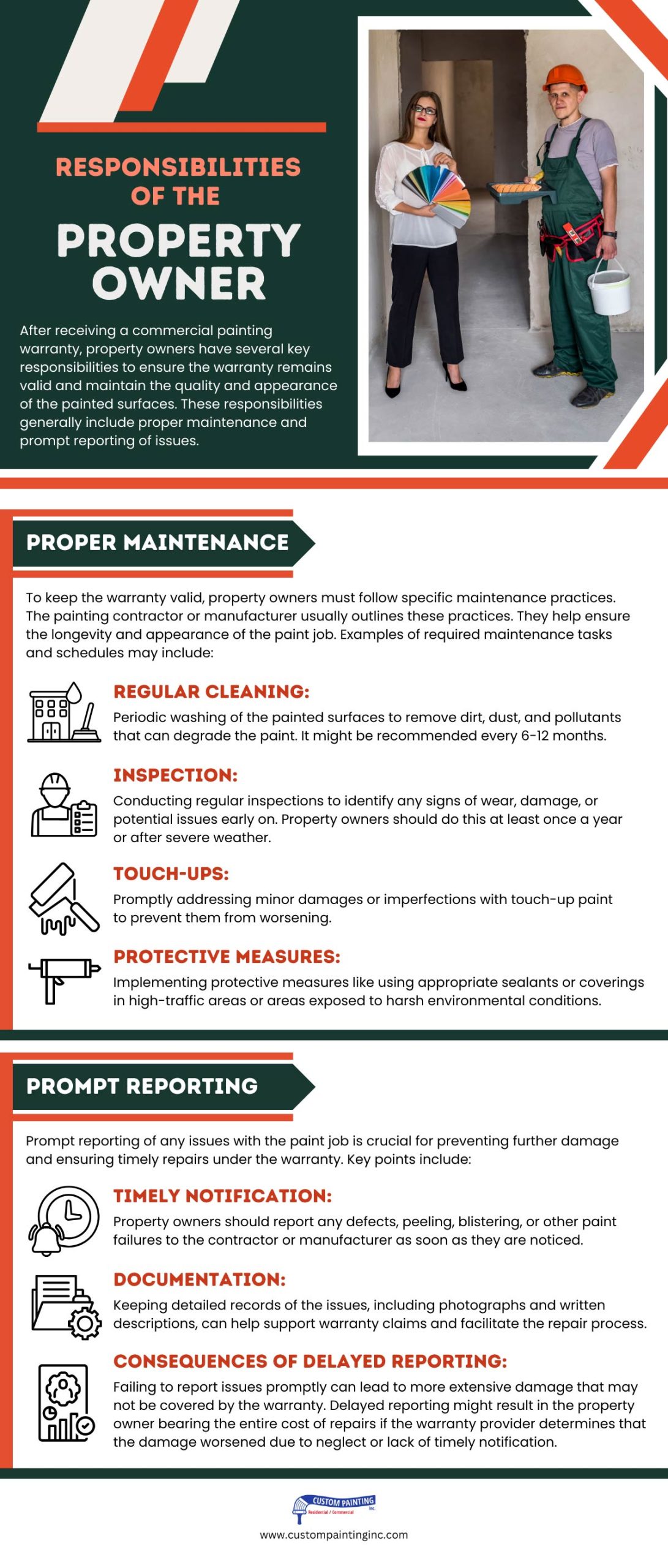When requesting a warranty from a commercial painter in the Pleasanton, CA area, it should always be in writing. A document of a warranty is crucial. It ensures the quality of the painter’s work, protects against defects, and holds the painter accountable for any issues. It provides peace of mind and assurance that problems will be addressed promptly, ultimately safeguarding your investment.
A comprehensive commercial painting warranty provides peace of mind and ensures the paint job’s quality and durability. Make sure to take into consideration project tasks that the contractor might be performing including breakroom cabinet refinishing and painting, wood rot repair and light carpentry work Here’s what a robust warranty should include from a professional painting company’s perspective.
Warranty Duration
Commercial painting warranties typically range from 1 to 5 years. Here’s a breakdown of the usual durations:
1. 1-Year warranty:
- Coverage: Often covers defects in craftsmanship and materials.
- Reason: Paint failures due to improper application or defective materials usually become apparent within the first year.
2. 3-Year Warranty:
- Coverage: Extends to issues like blistering, peeling, or excessive fading.
- Reason: This period allows for a more extended observation of the paint’s performance under varying environmental conditions.
3. 5-Year warranty:
- Coverage: Comprehensive coverage for defects and failures due to craftsmanship and materials.
- Reason: Shows confidence in the quality of the work and materials. It also aligns with the expected maintenance cycle of many commercial properties.
Coverage Over Time
The specifics of coverage can change or diminish over the warranty period:
1. Initial Full Coverage:
- During the first part of the warranty (e.g., the first year), the coverage is usually comprehensive, addressing any issues that arise without much hassle.
- Example: Full coverage for repairs due to peeling or blistering.
2. Diminishing Coverage:
- As the warranty progresses, the coverage might become more limited.
- Example: In the latter years of a 5-year warranty, coverage might only include specific defects, such as significant peeling or extensive fading, and may not cover minor aesthetic issues.
Importance of Understanding the Warranty Timeline
1. Knowing What’s Covered: To avoid unexpected costs, understand what the warranty covers at different stages. This includes knowing whether labor, materials, or both are covered.
2. Conditions and Exclusions: Warranties often have conditions and exclusions. Understanding these can prevent disputes and ensure compliance with the warranty terms (e.g., regular maintenance).
3. Negotiating Terms: Clear understanding allows for better warranty negotiation terms to suit specific needs and expectations.
Understanding the duration and coverage specifics of a commercial painting warranty is essential for maintaining a Livermore property’s value and appearance while avoiding unexpected expenses.
Coverage Details
Types of Issues Covered
Common Issues Included in a Warranty:
- Peeling: This occurs when the paint lifts away from the surface. It can happen due to poor surface preparation or the paint application in unsuitable conditions.
- Blistering: Blisters or bubbles form on the painted surface, typically caused by heat, moisture, or poor adhesion.
- Flaking: This involves the paint cracking and coming off in small pieces. It usually results from inadequate surface preparation using incompatible paint types.
Specific Conditions Under Which These Issues Are Covered:
- Proper Application: The warranty usually covers issues arising when the paint has the correct application according to the manufacturer’s and contractor’s guidelines.
- Adherence to Preparation Standards: Coverage often depends on whether the surface received correct preparation before painting, including cleaning, priming, and repairing any damages.
- Normal Use: The warranty applies under normal conditions of use and within typical environmental exposure for the location of the painted surface.
Exclusions and Limitations
Potential Exclusions:
- Structural Issues: Damage caused by underlying structural problems, such as foundation settling or water leaks, is typically not covered.
- Environmental Factors: Extreme weather conditions, pollution, or other environmental factors that affect the paint’s durability are usual exclusions.
- Improper Maintenance: Neglecting regular maintenance, such as cleaning the surface or promptly addressing minor damages, can void the warranty.
Importance of Reading and Understanding All Exclusions:
- Avoid Surprises: Thoroughly reading the warranty helps avoid unexpected expenses and ensures you know what is and isn’t covered.
- Preventative Measures: Understanding exclusions can help you take necessary preventive actions to maintain the integrity of the paint job.
- Informed Decisions: Knowledge of the warranty helps you make informed decisions about selecting a contractor and maintaining the painted surfaces properly.
Materials and Workmanship
Quality Assurance
- Materials Quality: Warranties often include clauses that guarantee the quality of materials used in the painting project. This means that the paints, primers, and other materials must meet specific standards and be sourced from reputable manufacturers. This assurance helps ensure that the materials perform as expected over the warranty period, providing durability and longevity.
- Workmanship: The warranty also covers the quality of workmanship, ensuring that the painting is applied by skilled professionals who adhere to industry standards. It includes proper surface preparation, correct application techniques, and following safety protocols. High-quality craftsmanship is crucial for achieving a flawless finish and maximizing the lifespan of the paint job.
Approved Products and Methods
- Specification of Approved Products: The contract will specify which products receive approval for use to maintain warranty validity. It might include particular brands, types of paint, and other materials. Using non-approved products can void the warranty because they may not meet the required performance standards.
- Approved Painting Methods: The warranty will also outline the approved methods for paint application. They include techniques for surface preparation, application, and curing processes. Adhering to these methods is critical because improper application can lead to premature failure of the paint job, such as peeling, cracking, or fading.
- Importance of Guidelines: Following these guidelines is essential to ensure coverage under the warranty. Deviations from the specified products or methods can result in voided warranties, leaving the client without protection against defects or failures. Adhering to the guidelines ensures that the painting project meets the expected quality standards and that the warranty remains intact.
Process for Making a Warranty Claim
Reporting an Issue
Step-by-Step Process for Reporting a Problem Under the Warranty:
1. Review Warranty Terms: Begin by carefully reviewing the warranty documentation provided by the painting company. Understand what the warranty covers, its duration, and any exclusions.
2. Identify the Issue: Identify the problem with the paint job. Usual issues may include peeling, blistering, fading, or cracking.
3. Gather Evidence: Take clear, high-resolution photos of the affected areas from different angles. Ensure the images are well-lit and detailed.
4. Document the Problem: Write a detailed description of the issue, including when it was first noticed, the location of the problem, and any possible contributing factors (e.g., weather conditions, exposure to moisture).
5. Locate Original Documentation: Find the original contract, receipt, and any other documents related to the paint job. These will often be required to verify the warranty.
6. Contact the Painting Company: Contact the painting company through their preferred communication method (e.g., phone, email, online form). Provide your name, contact information, and a summary of the issue.
7. Submit Evidence: Attach the gathered photos, detailed description, and any required documentation to your initial contact with the company.
8. Follow Up: After submitting your claim, follow up with the company to confirm receipt and inquire about the next steps.
Required Documentation and Evidence:
- High-resolution photos of the affected areas.
- A detailed description of the problem.
- Original contract and receipt.
- Warranty documentation.
- Any correspondence related to the original paint job.
Response and resolution timeframes
Expected Timelines for the Painting Company to Respond and Address Warranty Claims:
1. Initial Response: Most companies aim to acknowledge receipt of a warranty claim within 48 hours.
2. Claim Review: The company will review the submitted documentation and evidence. This process typically takes 5-10 business days.
3. Inspection: If necessary, a company representative may schedule an on-site inspection to assess the issue firsthand. This can take an additional 5-7 business days to arrange.
4. Resolution Proposal: After reviewing the claim and conducting any needed inspections, the paint company proposes a resolution. This step generally occurs within 15-20 business days from the initial claim submission.
5. Implementation: The timeline for completion will vary depending on the proposed resolution (e.g., repainting, repairs). Simple repairs might be completed within a week, while extensive work could take several weeks.
Communication Protocols and Customer Service Expectations:
Clear Communication: The company should maintain clear and transparent communication throughout the process, informing the customer of each step and expected timeframes.
Customer Service: The painting contractor should deliver the expected professional and courteous customer service. The company should be responsive to inquiries and provide timely updates.
Documentation: All communications, agreements, and resolutions should be documented in writing for both parties’ records.
Follow-Up: After the resolution is implemented, the company should follow up to ensure the customer is satisfied with the outcome and that the issue has been fully resolved.
Responsibilities of the Property Owner
After receiving a commercial painting warranty, property owners have several key responsibilities to ensure the warranty remains valid and maintain the quality and appearance of the painted surfaces. These responsibilities generally include proper maintenance and prompt reporting of issues.
Proper maintenance
To keep the warranty valid, property owners must follow specific maintenance practices. The painting contractor or manufacturer usually outlines these practices. They help ensure the longevity and appearance of the paint job. Examples of required maintenance tasks and schedules may include:
- Regular Cleaning: Periodic washing of the painted surfaces to remove dirt, dust, and pollutants that can degrade the paint. It might be recommended every 6-12 months.
- Inspection: Conducting regular inspections to identify any signs of wear, damage, or potential issues early on. Property owners should do this at least once a year or after severe weather.
- Touch-ups: Promptly addressing minor damages or imperfections with touch-up paint to prevent them from worsening.
- Protective Measures: Implementing protective measures like using appropriate sealants or coverings in high-traffic areas or areas exposed to harsh environmental conditions.
Prompt reporting
Prompt reporting of any issues with the paint job is crucial for preventing further damage and ensuring timely repairs under the warranty. Key points include:
- Timely Notification: Property owners should report any defects, peeling, blistering, or other paint failures to the contractor or manufacturer as soon as they are noticed.
- Documentation: Keeping detailed records of the issues, including photographs and written descriptions, can help support warranty claims and facilitate the repair process.
- Consequences of Delayed Reporting: Failing to report issues promptly can lead to more extensive damage that may not be covered by the warranty. Delayed reporting might result in the property owner bearing the entire cost of repairs if the warranty provider determines that the damage worsened due to neglect or lack of timely notification.
By adhering to these responsibilities, property owners in the Sunol, CA area can help ensure the longevity and appearance of their commercial paint job and make the most of their warranty coverage.
Benefits of a comprehensive warranty
Peace of Mind
Confidence in Durability and Quality
A robust warranty on a paint job assures customers of the high quality and durability of the work. Knowing the job is backed by a comprehensive warranty means the service provider is confident in their craftsmanship and materials. This confidence translates to peace of mind for the customer, who can trust that the paint job will withstand the test of time and elements.
Long-Term Benefits
A reliable warranty offers long-term benefits by ensuring that the contractor will address issues arising from the paint job without additional costs to the customer. This long-term security means that customers in the Fremont, CA area do not have to worry about the potential degradation of the paint job, allowing them to enjoy the aesthetic and protective benefits for years to come.
Financial Protection
Protection Against Unexpected Costs
A comprehensive warranty protects customers from unexpected repair costs and repainting expenses. If the paint job fails or shows defects within the warranty period, the service provider is responsible for fixing the issues at no extra charge. This protection shields customers from the financial burden of unforeseen repairs, which can be particularly beneficial if the paint job covers a large area or involves intricate details.
Cost Savings Examples
Warranty coverage can lead to significant cost savings. For example, if a homeowner’s exterior paint in Fremont begins to peel or fade prematurely, a robust warranty would cover the cost of repainting, saving the homeowner hundreds or even thousands of dollars. Similarly, businesses can avoid the financial strain of repainting large commercial spaces if issues arise, ensuring their premises remain visually appealing without additional expenses.
Conclusion
Business owners should choose a painting company that offers a comprehensive warranty. It ensures the work’s quality and durability and provides the clients with peace of mind, knowing the painting contractor will resolve any issues arising from the paint job.
Commercial property owners should inquire about warranties when selecting a painting company. Doing so demonstrates the company’s commitment to providing thorough and reliable coverage. By prioritizing a stable warranty, you invest in your commercial property’s long-term appearance and protection.
At Custom Painting, Inc., all our contracts have a one-year workmanship warranty (extended warranties are also available) provided right after project completion. Call us today at 925-294-8062 or use our contact form to inquire about our residential and commercial painting services, estimates, contracts, and warranties.





